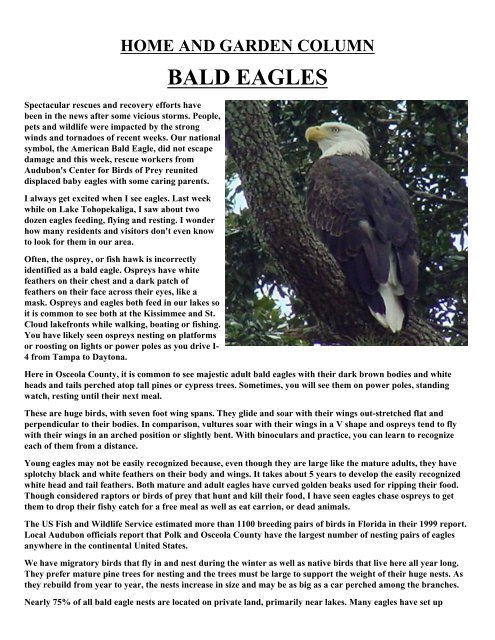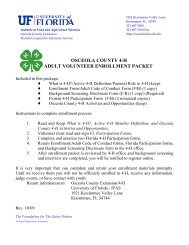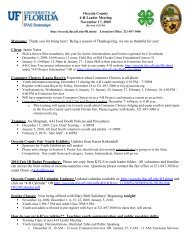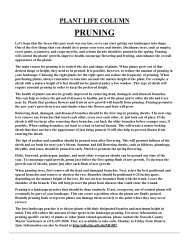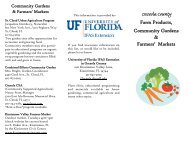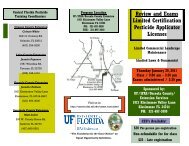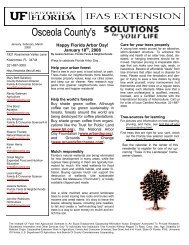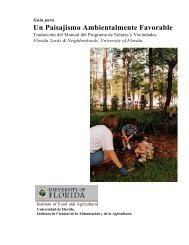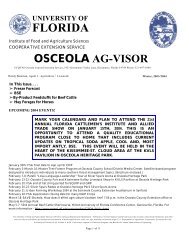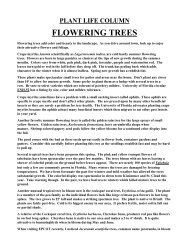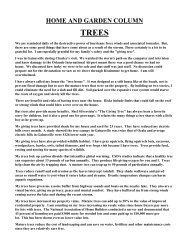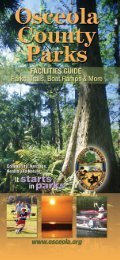Bald Eagles - Osceola County Extension - University of Florida
Bald Eagles - Osceola County Extension - University of Florida
Bald Eagles - Osceola County Extension - University of Florida
Create successful ePaper yourself
Turn your PDF publications into a flip-book with our unique Google optimized e-Paper software.
HOME AND GARDEN COLUMN<br />
Spectacular rescues and recovery efforts have<br />
been in the news after some vicious storms. People,<br />
pets and wildlife were impacted by the strong<br />
winds and tornadoes <strong>of</strong> recent weeks. Our national<br />
symbol, the American <strong>Bald</strong> Eagle, did not escape<br />
damage and this week, rescue workers from<br />
Audubon's Center for Birds <strong>of</strong> Prey reunited<br />
displaced baby eagles with some caring parents.<br />
I always get excited when I see eagles. Last week<br />
while on Lake Tohopekaliga, I saw about two<br />
dozen eagles feeding, flying and resting. I wonder<br />
how many residents and visitors don't even know<br />
to look for them in our area.<br />
Often, the osprey, or fish hawk is incorrectly<br />
identified as a bald eagle. Ospreys have white<br />
feathers on their chest and a dark patch <strong>of</strong><br />
feathers on their face across their eyes, like a<br />
mask. Ospreys and eagles both feed in our lakes so<br />
it is common to see both at the Kissimmee and St.<br />
Cloud lakefronts while walking, boating or fishing.<br />
You have likely seen ospreys nesting on platforms<br />
or roosting on lights or power poles as you drive I-<br />
4 from Tampa to Daytona.<br />
BALD EAGLES<br />
Here in <strong>Osceola</strong> <strong>County</strong>, it is common to see majestic adult bald eagles with their dark brown bodies and white<br />
heads and tails perched atop tall pines or cypress trees. Sometimes, you will see them on power poles, standing<br />
watch, resting until their next meal.<br />
These are huge birds, with seven foot wing spans. They glide and soar with their wings out-stretched flat and<br />
perpendicular to their bodies. In comparison, vultures soar with their wings in a V shape and ospreys tend to fly<br />
with their wings in an arched position or slightly bent. With binoculars and practice, you can learn to recognize<br />
each <strong>of</strong> them from a distance.<br />
Young eagles may not be easily recognized because, even though they are large like the mature adults, they have<br />
splotchy black and white feathers on their body and wings. It takes about 5 years to develop the easily recognized<br />
white head and tail feathers. Both mature and adult eagles have curved golden beaks used for ripping their food.<br />
Though considered raptors or birds <strong>of</strong> prey that hunt and kill their food, I have seen eagles chase ospreys to get<br />
them to drop their fishy catch for a free meal as well as eat carrion, or dead animals.<br />
The US Fish and Wildlife Service estimated more than 1100 breeding pairs <strong>of</strong> birds in <strong>Florida</strong> in their 1999 report.<br />
Local Audubon <strong>of</strong>ficials report that Polk and <strong>Osceola</strong> <strong>County</strong> have the largest number <strong>of</strong> nesting pairs <strong>of</strong> eagles<br />
anywhere in the continental United States.<br />
We have migratory birds that fly in and nest during the winter as well as native birds that live here all year long.<br />
They prefer mature pine trees for nesting and the trees must be large to support the weight <strong>of</strong> their huge nests. As<br />
they rebuild from year to year, the nests increase in size and may be as big as a car perched among the branches.<br />
Nearly 75% <strong>of</strong> all bald eagle nests are located on private land, primarily near lakes. Many eagles have set up
housekeeping in old pine trees in pastures. Our agricultural families have watched the eagle families raise their<br />
young from year to year.<br />
Biologists know it is important to protect mature pine forests within a half mile <strong>of</strong> the lakes where eagles prefer to<br />
feed and nest.<br />
You may be aware that there are large Developments <strong>of</strong> Regional Impact (DRI's) going in around Lake<br />
Tohopekaliga. Project planners are working closely with <strong>Florida</strong> Fish and Wildlife Conservation Commission staff,<br />
other environmental agencies, Audubon <strong>of</strong> <strong>Florida</strong> and citizens to assure protection for mature trees that are<br />
potential nest sites for bald eagles. There are also plans to protect large tracts <strong>of</strong> conservation land and enhance<br />
the habitat by planting former pasture land with pines that will mature in 40 to 60 years providing nesting sites<br />
into the distant future.<br />
Other developers are working beyond federal regulations to help the eagles. Recently, Standard Pacific Homes, the<br />
developer at Eagle Lakes <strong>of</strong>f Pleasant Hill Road where an eagle nest collapsed, made a $5000 donation to the<br />
Center for Birds <strong>of</strong> Prey to help with expenses related to eagle rescues.<br />
Learn more about eagles and what you can do to help them by contacting the Audubon Center for Birds <strong>of</strong> Prey at<br />
this web site or call 407-644-0190. They can always use volunteers with their Eagle Watch monitoring program. Be<br />
sure to check out their Eagle Cam online. The Center in Maitland is open to the public with a small visitation<br />
donation. Staff members do public outreach programs and gladly accept donations to help with their educational<br />
programs and rescues.<br />
Eleanor Foerste<br />
Natural Resources Agent<br />
<strong>Osceola</strong> <strong>County</strong> <strong>Extension</strong>/<strong>University</strong> <strong>of</strong> <strong>Florida</strong><br />
1921 Kissimmee Valley Lane<br />
Kissimmee, FL 34744<br />
(321) 697-3000<br />
Fax (321) 697-3010<br />
efoe@osceola.org<br />
osceola.ifas.ufl.edu<br />
Date: February 15th , 2007


